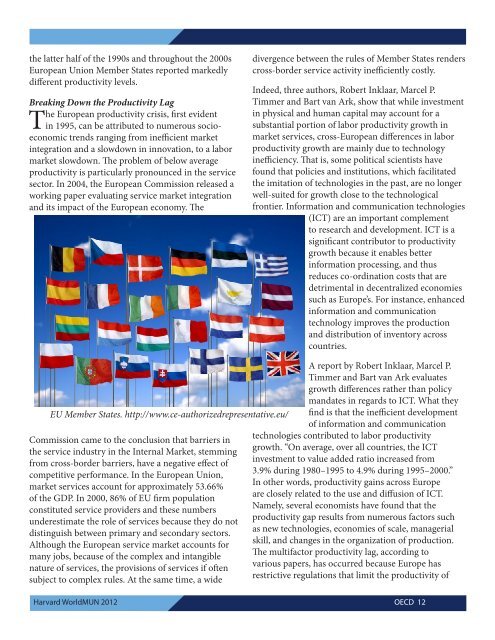Study Guide - World Model United Nations
Study Guide - World Model United Nations
Study Guide - World Model United Nations
Create successful ePaper yourself
Turn your PDF publications into a flip-book with our unique Google optimized e-Paper software.
the latter half of the 1990s and throughout the 2000s<br />
European Union Member States reported markedly<br />
different productivity levels.<br />
Breaking Down the Productivity Lag<br />
The European productivity crisis, first evident<br />
in 1995, can be attributed to numerous socioeconomic<br />
trends ranging from inefficient market<br />
integration and a slowdown in innovation, to a labor<br />
market slowdown. The problem of below average<br />
productivity is particularly pronounced in the service<br />
sector. In 2004, the European Commission released a<br />
working paper evaluating service market integration<br />
and its impact of the European economy. The<br />
A report by Robert Inklaar, Marcel P.<br />
Timmer and Bart van Ark evaluates<br />
growth differences rather than policy<br />
mandates in regards to ICT. What they<br />
EU Member States. http://www.ce-authorizedrepresentative.eu/<br />
find is that the inefficient development<br />
of information and communication<br />
Commission came to the conclusion that barriers in<br />
technologies contributed to labor productivity<br />
the service industry in the Internal Market, stemming<br />
growth. “On average, over all countries, the ICT<br />
from cross-border barriers, have a negative effect of<br />
investment to value added ratio increased from<br />
competitive performance. In the European Union,<br />
3.9% during 1980–1995 to 4.9% during 1995–2000.”<br />
market services account for approximately 53.66%<br />
In other words, productivity gains across Europe<br />
of the GDP. In 2000, 86% of EU firm population<br />
are closely related to the use and diffusion of ICT.<br />
constituted service providers and these numbers<br />
Namely, several economists have found that the<br />
underestimate the role of services because they do not<br />
productivity gap results from numerous factors such<br />
distinguish between primary and secondary sectors.<br />
as new technologies, economies of scale, managerial<br />
Although the European service market accounts for<br />
skill, and changes in the organization of production.<br />
many jobs, because of the complex and intangible<br />
The multifactor productivity lag, according to<br />
nature of services, the provisions of services if often<br />
various papers, has occurred because Europe has<br />
subject to complex rules. At the same time, a wide<br />
restrictive regulations that limit the productivity of<br />
Harvard <strong>World</strong>MUN 2012<br />
divergence between the rules of Member States renders<br />
cross-border service activity inefficiently costly.<br />
Indeed, three authors, Robert Inklaar, Marcel P.<br />
Timmer and Bart van Ark, show that while investment<br />
in physical and human capital may account for a<br />
substantial portion of labor productivity growth in<br />
market services, cross-European differences in labor<br />
productivity growth are mainly due to technology<br />
inefficiency. That is, some political scientists have<br />
found that policies and institutions, which facilitated<br />
the imitation of technologies in the past, are no longer<br />
well-suited for growth close to the technological<br />
frontier. Information and communication technologies<br />
(ICT) are an important complement<br />
to research and development. ICT is a<br />
significant contributor to productivity<br />
growth because it enables better<br />
information processing, and thus<br />
reduces co-ordination costs that are<br />
detrimental in decentralized economies<br />
such as Europe’s. For instance, enhanced<br />
information and communication<br />
technology improves the production<br />
and distribution of inventory across<br />
countries.<br />
OECD 12

















